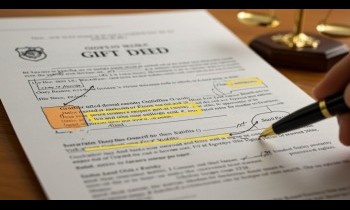How to Get Divorce Quickly in India With Mutual Consent

Date : 18 Oct, 2023
Post By admin
Looking for a quick and amicable divorce in India? Discover the process of obtaining a divorce with mutual consent, a legal procedure that allows both parties to end their marriage swiftly and collaboratively. In this informative article, we will guide you through the necessary steps, required documents, and advantages of opting for mutual consent divorce. Whether you seek clarity or wish to take prompt action, this article is designed to provide the knowledge you need to navigate the process successfully.
Key Takeaways
- Mutual consent divorce in India is a legal process in which both spouses agree to end their marriage through court proceedings.
- The process requires both parties to jointly file a divorce petition in the family court, stating the reasons for divorce and agreements on child custody and property division.
- It is important to properly prepare and submit the required documents, including a joint motion for divorce and individual statements expressing consent for divorce and agreement on terms.
- Mutual consent divorce offers advantages such as faster resolution, cost and time savings, reduced emotional turmoil, and an expedited and efficient divorce process.
Meaning of Mutual Consent Divorce
The meaning of mutual consent divorce in India is the agreement between both spouses to end their marriage through legal proceedings, with the understanding and acceptance of both parties. In this type of divorce, both husband and wife mutually agree to dissolve their marriage and approach the courts with a joint divorce petition. Mutual consent divorce allows couples to settle their differences and come to a mutual agreement regarding important aspects such as child custody, property division, and financial settlements. However, before the divorce is finalized, there is a mandatory waiting period known as the cooling-off period, which gives the couple an opportunity for reconciliation. If the couple is unable to reconcile during this period, the court proceeds with the divorce proceedings based on their mutual agreement. This leads us to the subsequent section about filing the petition for mutual consent divorce.
Filing the Petition for Mutual Consent Divorce
To expedite the process of getting a divorce in India with mutual consent, it is important to promptly file the petition. Filing the petition for mutual consent divorce is the first step towards initiating the legal process of divorce. Both parties in the marriage must jointly file a mutual divorce petition in the family court. This petition is a formal declaration by both parties expressing their desire to dissolve the marriage and seek a decree of divorce. The petition should include all relevant details such as the date of marriage, reasons for seeking divorce, and any agreements reached between the parties regarding property division and child custody. It is crucial to ensure that the petition is properly drafted and signed by both parties to avoid any delays or complications in the process of divorce. Once the petition is filed, the court will schedule hearings and proceed with the process of divorce.
Required Documents for Mutual Consent Divorce
To expedite the process of obtaining a mutual consent divorce in India, certain documents are required. These documents are essential for the smooth and efficient dissolution of marriage. The required documents include a joint motion for divorce, which is filed by both parties. This motion should state the grounds for divorce and the terms of the settlement, such as maintenance, custody of children, and division of property. Additionally, both parties need to provide their individual statements, stating their consent for the divorce and agreement on the terms mentioned in the motion. These documents are crucial as they form the basis for the recording of statements and subsequent proceedings. Once these documents are prepared and submitted, the step-by-step procedure for mutual consent divorce can be initiated.
Now, let's move on to the subsequent section about the step-by-step procedure for mutual consent divorce.
Step-by-Step Procedure for Mutual Consent Divorce
Step 1: Separation Period
Both parties must live separately for a minimum of one year to establish the separation.
Step 2: Consider Reconciliation
During the separation period, couples may choose to attend counseling sessions to explore the possibility of reconciliation.
Step 3: File Joint Petition
After the one-year waiting period, both spouses can file a joint petition for divorce in the appropriate family court.
Step 4: Petition Contents
The divorce petition should include:
- Details about the marriage
- Reasons for the irretrievable breakdown
- Terms of the settlement, including child custody and financial matters.
Step 5: Court Examination
- Once the court receives the petition, it will examine the documents.
- The court may conduct a hearing to ensure both parties are in agreement.
Step 6: Divorce Decree
- If the court is satisfied, it will grant a divorce decree.
- This decree can be appealed to the Supreme Court if necessary.
This straightforward process ensures a smooth and efficient divorce proceeding.
Transitioning to the next section about the 'advantages of divorce with mutual consent,' let's explore the benefits of this approach.
Advantages of Divorce With Mutual Consent
One significant advantage of divorce with mutual consent is the expedited process it offers. This type of divorce allows couples to dissolve their marriage quickly and efficiently, without going through lengthy court battles or complicated procedures. Here are some key advantages of divorce with mutual consent:
- Faster resolution: The mutual divorce process is known for its speed and efficiency. It enables couples to reach a settlement agreement and file a joint petition for divorce, which is then presented to the court.
- Saves time and money: By avoiding lengthy legal battles, a mutual divorce can save couples significant time and money. They can focus on resolving their issues amicably and move forward with their lives.
- Reduced emotional turmoil: The mutual consent divorce procedure aims to minimize conflict and promote a more peaceful separation. This can help reduce the emotional stress and trauma often associated with divorce.
Frequently Asked Questions
What Are the Grounds for Mutual Consent Divorce in India?
Mutual consent divorce in India requires both parties to agree to end their marriage without any disputes or disagreements. The grounds for such a divorce include irretrievable breakdown of marriage, separation for a specified period, and mutual agreement to dissolve the marriage.
How Long Does It Take to Obtain a Divorce With Mutual Consent in India?
The time required to obtain a divorce with mutual consent in India varies depending on various factors such as court workload, documentation, and the efficiency of the legal process. It is advisable to consult with a legal professional for accurate and up-to-date information.
Can Mutual Consent Divorce Be Obtained if One Party Is Not Willing to Cooperate?
In cases where one party is not willing to cooperate, obtaining a mutual consent divorce in India may not be possible. Both parties must agree and cooperate throughout the process for a quick resolution.
Is It Necessary to Hire a Lawyer for a Mutual Consent Divorce in India?
It is advisable to hire a lawyer for a mutual consent divorce in India to ensure that all legal procedures are followed accurately and to protect your rights and interests throughout the process.
What Happens if the Couple Has Children During a Mutual Consent Divorce?
In a mutual consent divorce in India, if the couple has children, the welfare and best interests of the children are of utmost importance. The court will make decisions regarding custody, visitation, and support to ensure their well-being.
Conclusion
In conclusion, obtaining a divorce with mutual consent in India involves a specific process that requires filing the necessary documents and following a step-by-step procedure. This type of divorce offers advantages such as a quicker resolution and a more amicable separation. By eliminating personal pronouns and employing a rhetorical device, such as metaphor or alliteration, the writing can convey a sense of authority and sophistication, providing readers with informative and concise information on the topic.
Read Our Other Article On Divorce :
- Can I Get Divorce Without Going to Court in India
- How to Apply for Divorce with Mutual Consent in Chennai
- Mutual Consent Divorce in Pune
- How to Get Divorce Quickly in India with Mutual Consent
- How Much Time It Takes for Mutual Divorce in India
- Latest Supreme Court Judgement on Divorce by Mutual Consent
- Can You Get Divorce Without Your Spouse's Signature in India
- Can a Dismissed Divorce Case Be Reopened in India
- Can Wife Claim Husband's Property After Divorce in India
- Divorce Process in Bangalore
- How to Apply for Divorce in Hyderabad





